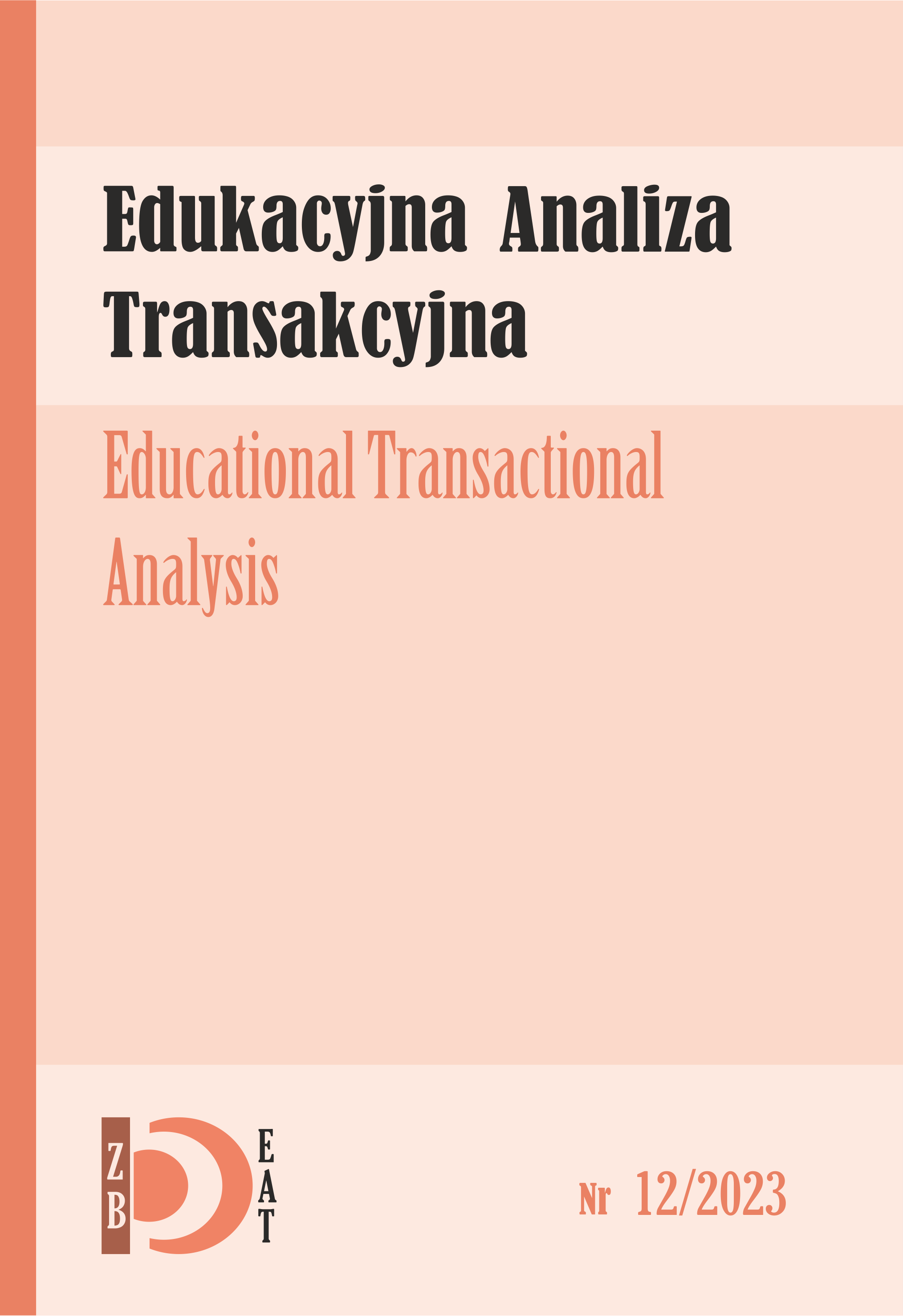Bunker/shelter as a Situated Learning Space: An Example of a Life Protection Experiment in Threatening
DOI:
https://doi.org/10.16926/eat.2023.12.14%20Keywords:
Bunker/shelter conditions, shelter experiment, situational learning.Abstract
The article describes the assumptions of an experiment and training conducted at the barracks of the Higher School of Justice (currently the Academy of Justice) in Kalisz. Sixty individuals were subjected to 12 hours of bunker deprivation. The studies conducted during the experiment focused on the utilization of bunkers as educational spaces where individuals learn effective life protection strategies in threatening conditions. The analyses encompass practical aspects such as physical preparedness for crisis situations and psychosocial aspects of learning in stressful conditions. The participants of the experiment underwent simulations of crisis situations. The project's aim was to describe the adaptation mechanisms of individuals to threatening situations in the context of life protection. The shelter/bunker can serve as a space supporting situated learning, preparing individuals for effective action in crisis conditions. The text presents those elements of the theory and research from the field of situated learning that should be taken into account in the didactic planning of training sessions for services conducted in bunkers/shelters.
Downloads
References
Bąkowska, E. (2022, December 9). 60 osób zamkniętych w schronie przeciw-lotniczym w Kaliszu. Polska Agencja Prasowa; https://www.pap.pl/aktualnosci/news%2C1503275%2C60-osob-zamknelo-sie-w-schronie-przeciwlotniczym-w-kaliszu.html (Accessed: Ja-nuary 5, 2024).
Chang, H.-S., Liao, C.-H. (2014). Planning emergency shelter locations based on evacuation behavior. Natural Hazards, 76(3), 1551–1571; https://doi.org/10.1007/s11069-014-1557-x.
Chen, W., Fang, Y., Zhai, Q., Wang, W., Zhang, Y. (2020). Assessing emergen-cy shelter demand using POI data and evacuation simulation. ISPRS In-ternational Journal of Geo-Information, 9(1), 41; https://doi.org/10.3390/ijgi9010041.
Clancey, W.J. (1995). A tutorial on situated learning. Proceedings of the International Conference on Computers and Education (Taiwan) (J. Self, Red.). Charlottesville, VA: AACE, 49–70; http://methodenpool.uni-koeln.de/situierteslernen/clancey_situated_learning.PDF (Accessed January 5, 2024).
Collins, A. (2006). Cognitive Apprenticeship. In: R.K. Sawyer (Ed.), The Cam-bridge handbook of: The learning sciences (pp. 47–60). Cambridge Uni-versity Press.
Collins, A., Brown, J.S., Newman, S.E. (1988). Cognitive Apprenticeship. Thinking: The Journal of Philosophy for Children, 8(1), 2–10.
Collins, A., Brown, J.S., Holum, A. (1991). Cognitive apprenticeship: Making thinking visible. American Educator, 3, 6–11.
Goel, L., Johnson, N., Junglas, I., Ives, B. (2010). Situated learning: Concep-tualization and measurement. Decision Sciences Journal of Innovative Education, 8(1), 215–240; https://doi.org/10.1111/j.1540-4609.2009.00252.x.
Hanks, W.F. (1991). Foreword. In: J. Lave, & E. Wenger, Situated Learning: Legitimate Peripheral Participation (p. 14). New York: Cambridge University Press.
Innowacyjny eksperyment naukowy w Szkole Wyższej Wymiaru Sprawiedli-wości (2022, December 12); https://swws.edu.pl/innowacyjny-eksperyment-naukowy-w-szkole-wyzszej-wymiaru-sprawiedliwosci/ (Ac-cessed January 5, 2024)
Kowalczyk, K.A. (2019). Geopolityczne dążenia współczesnej Rosji. Przegląd Geopolityczny, 27, 78–92.
Krawczyk, M.M. (2022). Mapa wojen i konfliktów na świecie. Retrieved from https://wszystkoconajwazniejsze.pl/mateusz-m-krawczyk-mapa-wojen-i-konfliktow-na-swiecie/ (Accessed January 5, 2024).
Lave, J., Wenger, E. (1991). Situated Learning: Legitimate Peripheral Partic-ipation. Cambridge: Cambridge University Press; http://dx.doi.org/10.1017/CBO9780511815355 (Accessed January 5, 2024).
Łużyński K. (2022, December 12). 60 osób zamkniętych w schronie – ruszył eksperyment SWWS-u! Latarnik kaliski; https://latarnikkaliski.pl/60-osob-zamknietych-w-schronie-ruszyl-eksperyment-swws-u/ (Accessed January 5, 2024).
Mölling, Ch., & Schütz, T. (2023). Preventing the Next War (#EDINA III) | DGAP. (b. d.-b). German Council on Foreign Relations | DGAP; https://dgap.org/en/research/publications/preventing-next-war-edina-iii (Accessed January 5, 2024).
Nagarajan, M., & Shaw, D. (2021). A behavioural simulation study of allocat-ing evacuees to public emergency shelters. International Journal of Disaster Risk Reduction, 55, 102083; https://doi.org/10.1016/j.ijdrr.2021.102083.
Piłat B. (2022, December 10). Spędzili w schronie 12 godzin. Nietypowy eksperyment na kaliskiej uczelni. RMF24 - Najbliżej faktów - Wydarzenia z Polski i Świata; https://www.rmf24.pl/regiony/poznan/news-spedzili-w-schronie-12-godzin-nietypowy-eksperyment-na-kalis,nId,6470476#crp_state=1
Polsat News. (2022, December 10). Zamknęli kilkadziesiąt osób w schronie. Eksperyment uczelni. polsatnews.pl; https://www.polsatnews.pl/wiadomosc/2022-12-10/kalisz-zamkneli-kilkadziesiat-osob-w-stuletnim-schronie-to-byl-eksperyment/ (Accessed January 5, 2024).
Polska w NATO – ministerstwo spraw zagranicznych – portal gov.pl. (b.d.). Ministerstwo Spraw Zagranicznych; https://www.gov.pl/web/dyplomacja/polska-w-nato.
Projekt Rozporządzenia Ministra Spraw Wewnętrznych i Administracji w sprawie warunków technicznych, zasad użytkowania, kontroli i ewiden-cjonowania obiektów budowlanych stanowiących obiekty zbiorowej ochrony i służących bezpieczeństwu lub obronności państwa. (b.d.) Re-trieved form https://www.google.com/url?sa=t&rct=j&q=&esrc=s&source=web&cd=&cad=rja&uact=8&ved=2ahUKEwjQrP7dy9GCAxUfZ_EDHX0_B1UQFnoECA0QAQ&url=https%3A%2F%2Fpracodawcy.pl%2Fwp-content%2Fuploads%2F2023%2F04%2FOSR-MSWiA-obiekty-zbiorowej-ochrony.docx&usg=AOvVaw2N5O1lWzML2ChowajUdqSC&opi=89978449 (Accessed January 5, 2024).
Raport PSP dotyczący budowli ochronnych 2023 (2023). Retrieved from https://www.gov.pl/attachment/01b014d1-8f4b-4a5f-9554-2e017e3be7d9 (Accessed January 5, 2024).
Redakcja GazetaPrawna.pl. (2023, April 11). Większość Polaków uważa, że wojna na Ukrainie zagraża ich bezpieczeństwu [SONDAŻ CBOS]. Gazeta-Prawna.pl – biznes, podatki, prawo, finanse, wiadomości, praca; https://www.gazetaprawna.pl/wiadomosci/kraj/artykuly/8697301,wojna-w-ukrainie-zagrozenie-dla-polski-sondaz-cbos.html (Accessed January 5, 2024).
Samulak-Andrzejczak, E. (2022, December 9). Eksperyment w kaliskim schronie. 60 osób zamknęło się tutaj na 12 godzin. Jak sobie poradzą? ZDJĘCIA. Kępno Nasze Miasto; https://kepno.naszemiasto.pl/eksperyment-w-kaliskim-schronie-60-osob-zamknelo-sie-tutaj/ar/c1-9125587.
Serafin, K. (2011). Identyfikacja potrzeb szkoleniowych jako istotny obszar działań w zarządzaniu personelem. Problemy Zarządzania, 9(4), 191.
Siemieniecka D., Majewska K. (2023, in print). Smartphone Loss and the Subjective Stress Levels of Individuals Enclosed in a Threatening Situa-tion – Results of Survey Research conducted in a Shelter, Law, Educa-tion, Security, 121(4).
Siemieniecka, D., Siemieniecki, B. (2019). Teorie kształcenia w świecie cy-frowym. Kraków: Oficyna Wydawnicza Impuls.
Welle, F.H.D. (2023, November 18). NATO kontra Rosja. Za kilka lat Kreml może zaatakować Europę. Rzeczpospolita; https://www.rp.pl/konflikty-zbrojne/art39430321-nato-kontra-rosja-za-kilka-lat-kreml-moze-zaatakowac-europe.
Yu, J., Zhang, C., Wen, J., Li, W., Liu, R., Xu, H. (2018). Integrating multi-agent evacuation simulation and multi-criteria evaluation for spatial al-location of urban emergency shelters. International Journal of Geo-graphical Information Science, 32(9), 1884–1910; https://doi.org/10.1080/13658816.2018.1463442.
Zhang, Z., Hu, Y., Lu, W., Cao, W., Gao, X. (2023). Spatial accessibility analy-sis and location optimization of emergency shelters in Deyang. Geomat-ics, Natural Hazards and Risk, 14(1); https://doi.org/10.1080/19475705.2023.2213809.
Zimbardo, P. G., Maslach, C., Haney, C. (2000). Reflections on the Stanford Prison Experiment: Genesis, transformations, consequences. In: T. Blass (Ed.), Obedience to authority: Current perspectives on the Milgram par-adigm (pp. 193–237). Lawrence Erlbaum.
Downloads
Published
How to Cite
Issue
Section
License
Copyright (c) 2023 Dorota Anna Siemieniecka

This work is licensed under a Creative Commons Attribution 4.0 International License.
I am aware that the Educational Transactional Analysis journal is published under a Creative Commons license - Attribution (https://creativecommons.org/licenses/by/4.0/legalcode).
By submitting the article, I agree to make it available under this license

